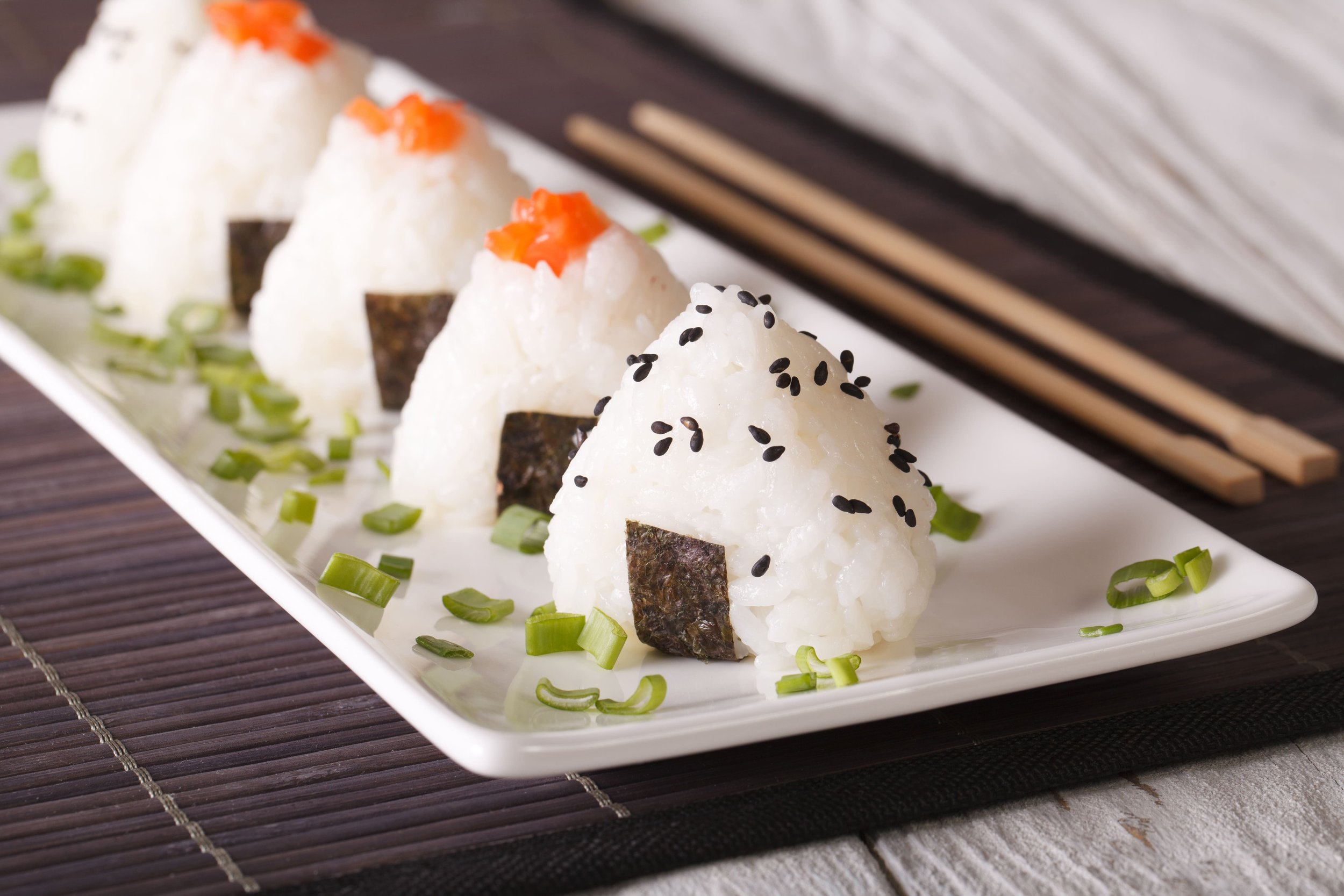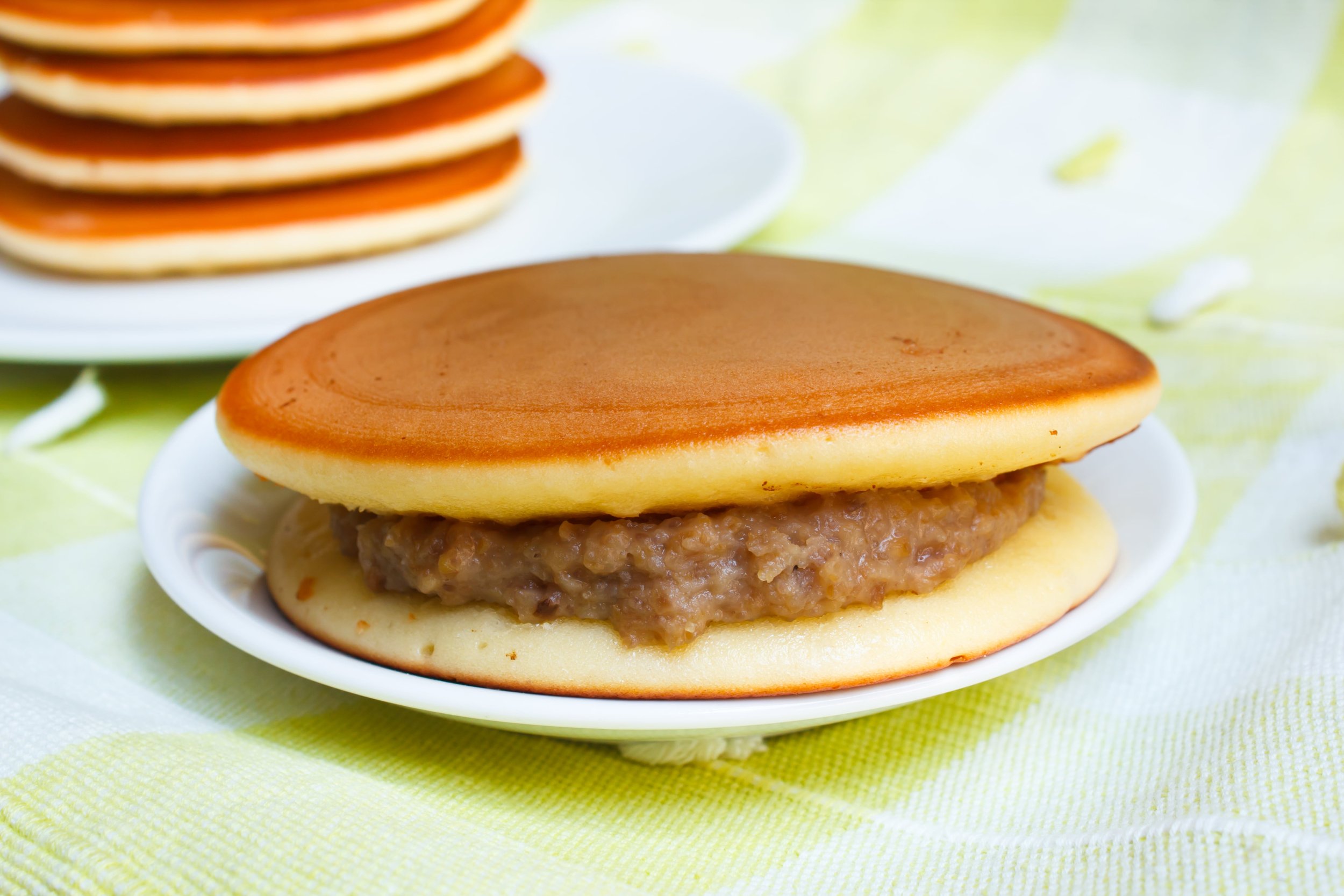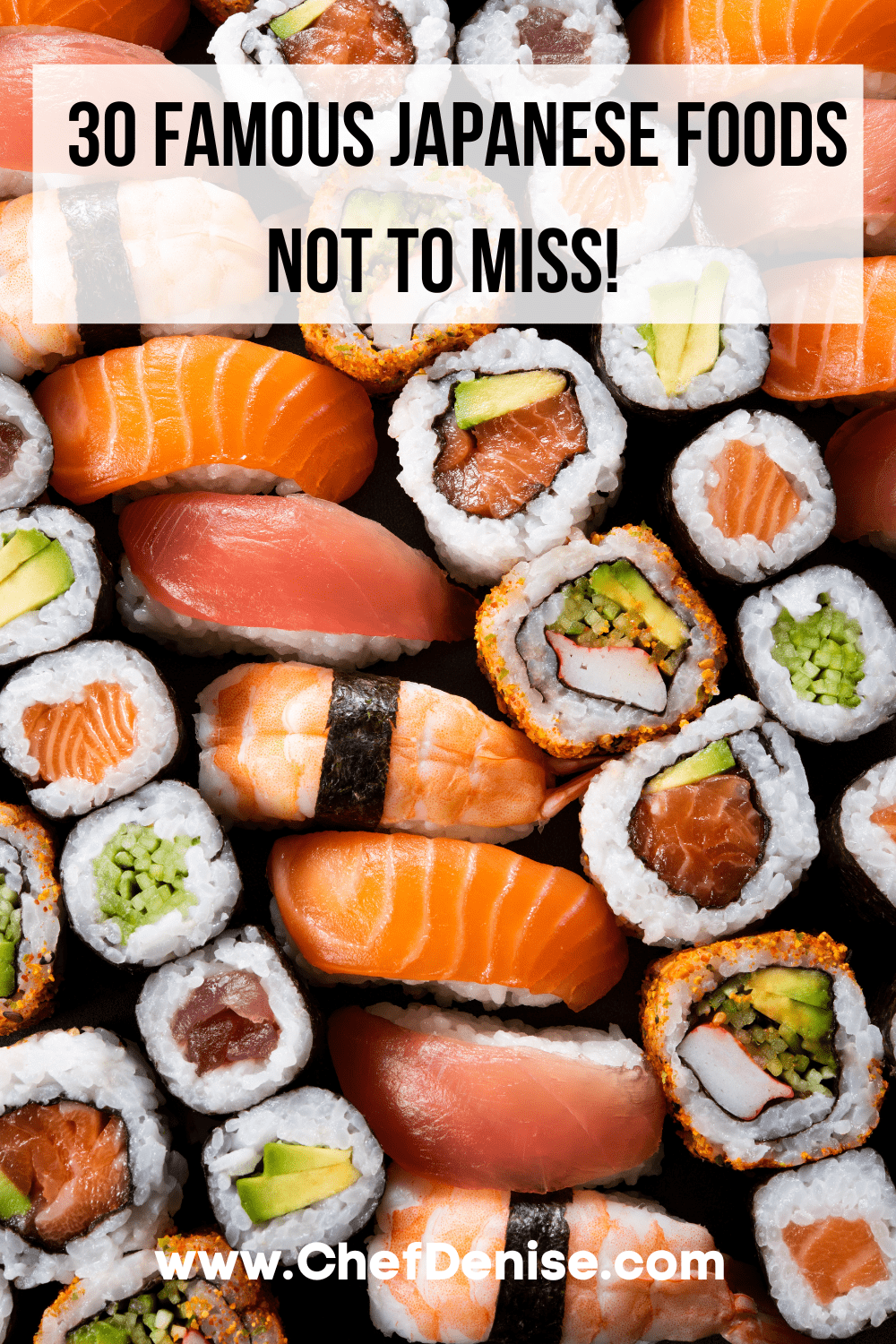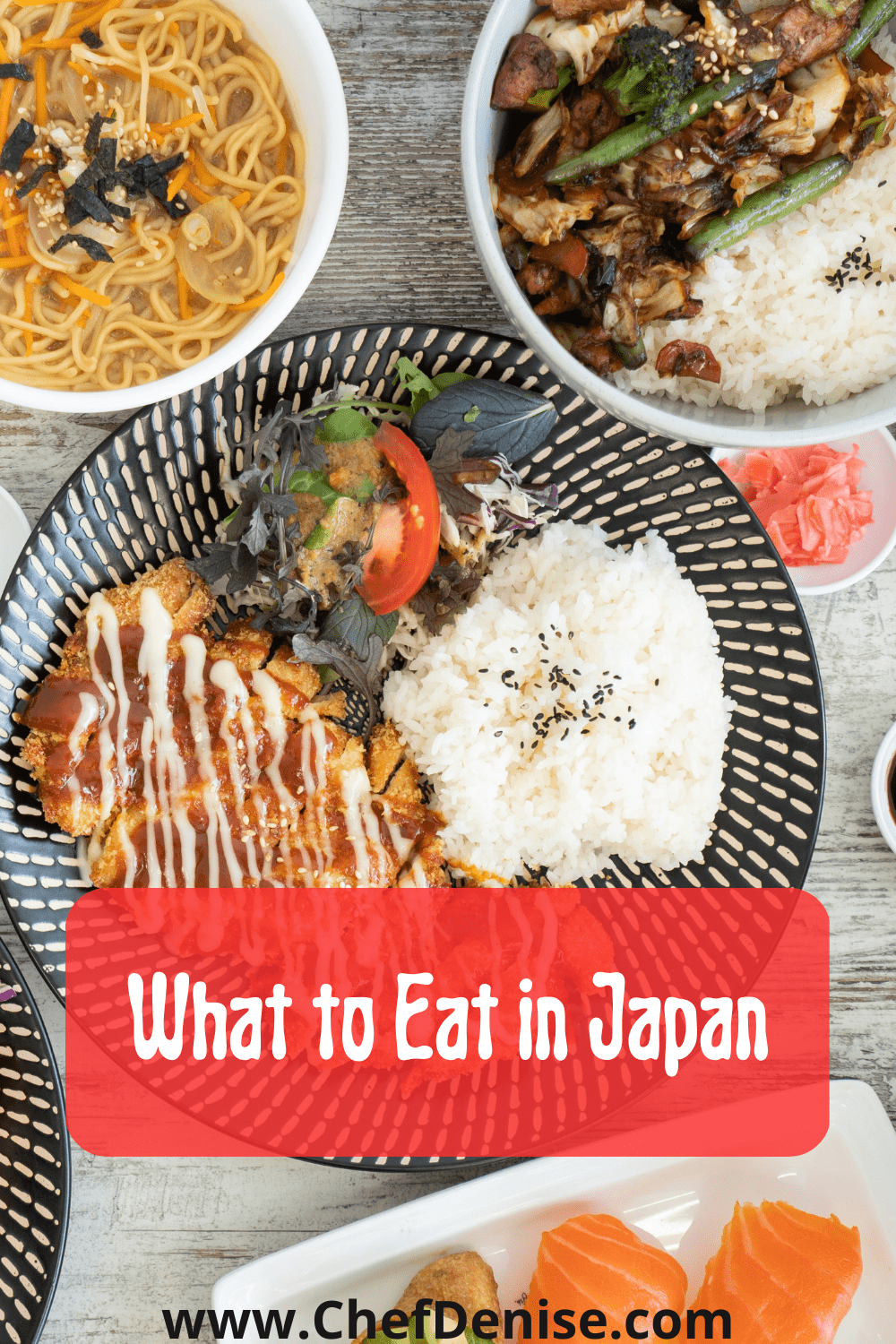30 Famous Japanese Foods Not To Miss!
Want to know what to eat in Japan or at your favorite Japanese restaurant? When it comes to famous Japanese food, there are so many mouthwatering dishes to try! Japan is a country with a rich culture and history, and this is reflected in its gastronomy.
Japanese cuisine is known for being healthy, delicious, and beautifully presented. In fact, only the food of France boasts more Michelin stars!
From traditional Japanese dishes like sushi and sashimi to modern-day ramen and tempura, there's something for everyone to enjoy when visiting Japan.
In addition to what you have already tried at home, seek out the traditional Japanese foods that you may not be familiar with. Popular Japanese dishes like karaage chicken, shabu shabu, and tamagoyaki are just a few of the inviting options that await your taste buds!
If you’re a foodie like me, these famous Japanese dishes will make your trip unforgettable!
Whether you want to sample the flavors of Tokyo or explore regional cuisines around the country, Japan’s culinary prowess will win you over.
Famous Japanese Foods
1. Sushi
When you think of Japanese cuisine, one of the first dishes that comes to mind has to be the most famous Japanese dish, sushi. So, of course, we’ve put it at the top of the list!
This most popular food can be served as an appetizer or a main course. The most popular type of sushi is nigiri sushi, which consists of a slice of raw fish atop a small mound of vinegared rice. The sushi rice has a sticky consistency so that you can easily pick it up.
Other types of sushi include maki, where rice and fillings are rolled in seaweed and sliced, and temaki, aka hand rolls, that look like a sushi cone. All sushi is usually accompanied by pickled ginger, wasabi, and soy sauce.
You can find almost any kind of raw seafood in Japanese restaurants. Fresh fish like salmon or tuna, and more exotic options like ika (squid) and uni (sea urchin) just scratch the surface.
There is really an almost endless variety, so be sure to try as many different types as you can while you're in Japan! Is Japan expensive to eat sushi? It can be, but you can also always find a bargain!
2. Sashimi
No famous Japanese foods list would be complete without sashimi! Sashimi is a dish of raw seafood that is sliced into thin pieces and served cold with soy sauce, wasabi, and other condiments.
Each type of seafood has its own unique texture, refreshing flavor, and delicate essence that make these dishes so popular throughout Japan.
Sashimi can be made from almost any type of seafood, such as tuna, salmon, red snapper, or squid, to name just a few options. It tastes incredibly fresh—as if the seafood has just been pulled straight out the sea.
Not surprisingly, sashimi is popular among locals and tourists alike! It’s a must-try when visiting Japan!
3. Tempura
Portuguese missionaries in the 16th century introduced tempura to Japan. Fun fact, the name of this famous food of Japan actually comes from Latin. “Tempora cuaresme” means “in the time of Lent,” because that’s when the original dish was consumed.
Tempura can be seafood or vegetables that have been coated in a batter before being fried. The tempura batter usually consists of wheat flour mixed with cold water and egg whites for added lightness.
A very popular Japanese food, tempura can be served as an appetizer or part of a larger meal with white rice or noodles. And sometimes, you’ll find it as an entrée with dipping sauces like soy sauce, tentsuyu (a sweetened soy sauce), or ponzu sauce.
4. Ramen
Although ramen is one of the most famous Japanese dishes, it originated in China. Chinese immigrants brought it to Japanese Chinatowns like Yokohama in the 19th century, and its popularity spread throughout Japan. Today, a steaming bowl of ramen is one of the staples of Japanese cuisine.
Ramen noodles are made from wheat and are served in a broth made from meat or fish. The exquisite broth can be flavored with soy sauce, miso paste, or tonkotsu (pork bone broth). The rich-flavored broth of tonkotsu ramen is my favorite.
Adding extra toppings such as eggs, seaweed, scallions, pork belly slices, bean sprouts, and shiitake mushrooms give the noodle soup more flavor and texture.
One of the most popular dishes in Japan, ramen can be found anywhere from street stalls to high-end restaurants.
5. Tonkatsu
The smell of tonkatsu will make your mouth water before you even take a bite!
This Japanese specialty consists of slices of pork that have been breaded in panko bread crumbs and fried. This deep-fried pork cutlet is usually served with shredded cabbage and dipping sauce. Sauces can be mild like tonkatsu sauce (which is Worcestershire based) or spicy like karashi (a tangy mustard).
6. Teriyaki
One of the most popular Japanese foods in the western world, teriyaki is not just a sweet sauce. Invented by Japanese chefs in the 17th century, teriyaki in Japan refers more to a cooking technique.
In this Japanese cooking process, chefs brush food with a sweet soy sauce marinade before and during grilling or broiling.
In Japan, you will commonly find teriyaki fish like yellowtail, salmon, trout, marlin, and mackerel. In the West, you’ll find more teriyaki chicken or beef.
7. Takoyaki
Created by a street vender in Osaka, takoyaki can now be found all over Japan. Although they remain a popular Japanese street food, they are now even available in some grocery stores.
They are sometimes called Japanese octopus balls in English. That’s because of their shape, not their anatomy, as is the case with the famous Colorado food, Rocky Mountain Oysters.
Made from a batter with small pieces of octopus mixed in, these bite-sized balls are cooked in a special takoyaki pan. During the process, vendors brush them with takoyaki sauce (similar to Worcestershire sauce) and mayonnaise. Then they sprinkle the takoyaki with green onions and bonito flakes (dried fish shavings).
8. Kare Raisu
The British introduced kare raisu, or curry rice, to Japan during the Meiji Era (1868–1912). Curry stew over rice adapted well to mass production, and curries became a staple in the Japanese army and school cafeterias.
Nowadays, curry rice is one of the most popular foods in Japan. Curry rice can be made with either chicken or beef, and it is often served with a red relish called fukujinzuke.
Japanese curry is usually milder than its Indian counterpart, but it is still flavorful enough to thoroughly enjoy!
9. Gyudon
The Japanese beef bowl, gyudon, dates back to the late 19th century. Prior to that time, for religious reasons, Japanese people rarely consumed beef. As Japanese culture became more westernized, beef became more accepted, and gyudon became a popular food.
It is a simple meal consisting of a bowl of rice topped with thinly sliced beef and onions that have been simmered in a sweetened soy sauce–based broth. Gyudon is often eaten with pickled ginger, shredded cabbage, and an egg on top.
Gyudon can be found at most casual restaurants across Japan at a reasonable price.
10. Yakitori
A popular street food in Japan, yakitori is commonly sold at street stalls throughout the country.
Yakitori refers to skewered chicken that has been grilled over charcoal. The chicken is typically marinated in yakitori sauce, a sweetened soy sauce, before being grilled.
This traditional Japanese food can be made with almost any part of the chicken. Everything from the breast, thigh, offal such as liver, and even chicken skin can be skewered!
11. Okonomiyaki
Okonomiyaki is sometimes referred to as "Japanese pizza.” I think of it more as a savory pancake.
The pancake-like batter can be filled with many different ingredients. Common choices include cabbage, bacon, shrimp, cheese, and egg. Okonomiyaki is grilled on both sides until it is crispy on the outside but still soft in the center. Then it is drizzled with sweet and tangy sauces.
The most famous food from Osaka, okonomiyaki can now be found at food stalls and restaurants all over Japan.
12. Mochi
This is a most popular snack! Mochi is a type of Japanese rice cake that is made from glutinous rice flour and water.
These chewy rice cakes come in all kinds of flavors, from matcha to sweet potato. They may also have different fillings such as bean paste or fruit jam.
Mochi is often eaten during Japanese festivals or given as gifts during New Year's celebrations.
13. Donburi
Donburi is a famous dish of Japan and a classic staple on any Japanese menu. It originated centuries ago in the Edo Period, when it was served at family tables.
The popular dish is typically served during lunchtime as a hearty, satisfying meal. It consists of a bowl of white rice topped with an assortment of vegetables, proteins, and flavorings.
Donburi’s common toppings include raw egg, chicken, beef, seafood, carrots, seaweed, teriyaki sauce, and miso sauce. This rice bowl is famous throughout Japan due to its unique flavor combinations.
Although donburi can be found elsewhere in the world, it is best enjoyed in its country of origin, where more traditional flavors predominate, and local ingredients take center stage atop the bed of rice.
14. Miso Soup
Miso soup is one of the most popular Japanese dishes worldwide. It originated in Japan centuries ago, and it remains a ubiquitous Japanese menu item still enjoyed today.
This quintessential Japanese soup’s unique flavor comes from its two main ingredients—miso paste (fermented soybeans) and dashi broth (a fish-and-kelp broth). The combination of these ingredients creates a meaty and savory flavor that goes perfectly with sushi and other classic Japanese dishes.
One of Japan’s greatest comfort foods, it’s especially tasty on a cold day. However, you’ll appreciate an authentic miso soup in any weather.
15. Onigiri
Onigiri, otherwise known as Japanese rice balls, is a popular and convenient fast food. Its origins can be traced back more than 2 millennia, to the Yayoi Period, and onigiri have been enjoyed as a popular fast food item ever since.
They typically consist of white rice formed into triangular or cylindrical shapes and stuffed with all kinds of fillings. Onigiri come in a variety of tasty flavors like umeboshi (pickled ume plum), okaka (dried bonito flakes) and ebikko (marinated salmon).
This iconic snack can be found in many locations, including supermarkets, convenience stores, food stalls, train stations, and nearly anywhere else food is served! Onigiri has become an irreplaceable staple Japanese food because of its quick preparation time and convenience, making it perfect for those on the go!
16. Edamame
Edamame most certainly rank as one of the most famous foods in Japan. Chefs incorporate these steamed or boiled soy beans into Japanese recipes in various ways.
They are often ordered with a dash of soy sauce as an appetizer or side dish. They can also be enjoyed on their own, salted as a snack.
Beware, the somewhat grassy, sweet, nutty flavor of edamame can be addictive. But since they are a famous Japanese snack, at least you’ll have no problem tracking them down. From grocery stores to famous izakayas (Japanese pubs), edamame are always close by.
17. Udon Noodles
Udon noodles are thick, chewy, wheat noodles that have been eaten in Japan since the 8th century. Udon originated in Japan, and it has become one of the best Japanese food staples.
Udon can be served either hot or cold for a delicious meal, such as udon noodle soup, udon tempura, or udon noodle salad with various toppings. What really makes udon popular is its taste and texture; the slightly firm but chewy thick noodles make a super yummy bowl of any kind.
Udon dishes can be found all over Japan—from small izakayas to large udon specialty stores where you can choose from dozens of hearty and flavorful udon dishes. Udon is especially beloved in the Kansai region, where udon dishes like sanuki udon and kitsune udon vie to reign supreme.
18. Soba Noodles
Soba are a popular type of noodle in Japan and can be found incorporated into different dishes at most restaurants. They originated in Japan, and are made from buckwheat flour. Soba noodles have a distinct earthy flavor compared to other types of Japanese noodles such as udon or ramen.
There are many ways soba noodles may be served, ranging from hot dishes such as kitsune soba (soba served with a thin deep-fried tofu) to cold dishes such as zaru soba. The main difference between the hot and cold dish is that cold dishes often come with a soy sauce dip, while hot dishes typically come with added sesame oil for flavor.
Cold noodle dishes also tend to be eaten with chopsticks, while hot dishes can also come with soup spoons, which in my opinion make them even more enjoyable. Soba noodles are generally considered healthy due to their relatively low carbohydrate content, which makes them popular among dieters.
Few foods feature as prominently in Japanese cuisine as soba noodles, making them easy to find throughout the country. Whether you are searching for them in traditional Japanese restaurants, hole-in-the-wall places servicing delicious ramen, or simple street food stalls selling zaru soba by the side of the road, one thing’s for sure: You won't starve before you track them down!
19. Gyoza
Gyoza, a classic Japanese dish of bite-sized dumplings filled with pork and veggies, make a terrific snack any time of day.
This popular food can be prepared many ways, including being boiled, pan-fried, deep-fried, and steamed. Many Japanese chefs believe pan-frying them on one side is the best way to cook them. This creates a lightly salted crunchy exterior that gyoza fans adore.
While there are many scrumptious variations of gyoza around the world, they are a must-eat in Japan! There you will find gyoza in traditional pubs as well as modern Japanese restaurants.
20. Karaage
Japanese for "fried chicken," karaage originated in the Nagoya prefecture. Bite-sized pieces of chicken are marinated in a special sauce and then deep-fried to perfection. As soon as you smell its enticing aroma, you’ll want to try this Japanese famous food.
Japanese fried chicken has a thin crispy coating spiced with seasonings like garlic, ginger, and soy sauce that give it an unmistakable Japanese flavor. When you take a bite, you get a burst of juicy goodness from the marinated chicken.
Traditionally, at restaurants in Japan, karaage is served as part of multi-course meals, but it can also be enjoyed simply over rice.
21. Shabu shabu
Shabu Shabu refers to the hotpot cooking technique within Japan's gastronomy. This technique is the centerpiece of a dining experience in which thinly sliced meat and vegetables cook at the diner’s table in a hot broth.
The name shabu shabu translates to swish swish, describing the sound of ingredients being stirred in the hotpot as they cook. After the appropriate amount of swishing, the end result is a delicious blend of flavors and textures that is uniquely satisfying.
Shabu Shabu is served with condiments such as soy sauce, ponzu, sesame seed paste, or tsuyu. For those who like their food with a bit more bite, chili peppers are also added to the mixture for added flavor.
Shabu Shabu can be enjoyed in traditional Japanese restaurants that specialize in this style of cooking, as well as in izakayas and yakiniku grill houses across the country.
22. Unagi
Unagi is the Japanese word for freshwater eel and has been a part of the country’s cuisine for centuries.
Popular unagi dishes include unadon and kabayaki; both are served over steamed rice. For unadon, the freshwater eel is steamed, and for kabayaki, it is grilled with teriyaki sauce.
Many other different types of unagi dishes can be found all over the country, ranging from those prepared by street food vendors to those featured at high-end restaurants.
23. Matcha Ice Cream
Matcha ice cream is a popular food Japan loves! It basically takes Japanese green tea powder, known as matcha, and transforms it into ice cream form! Who doesn’t love ice cream?
Its distinctive taste—a mix of sweetness and nuttiness, with a hint of bitterness—makes this Japanese dessert a popular choice all over the country.
As one of Japan's best-known traditional desserts, matcha ice cream appears on Japanese restaurant menus and at specialty ice cream cafes. Try matcha ice cream with mochi, in parfaits, in waffle cones, and/or in its soft serve variation.
24. Katsu Sando
Katsu Sando is the king of Japanese sandwiches. Basically, it’s a fried, breaded pork cutlet put between two slices of shokupan, a fluffy white bread.
A variety of ingredients may accompany the pork cutlet, such as shredded cabbage, tonkatsu sauce, mustard, and other dressings. Many merchants concoct their own variations of katsu sando, so don’t hesitate trying versions from more than one vendor.
Katsu Sando can be found pretty much on every corner in Japan at convenience stores, train station kiosks, and restaurants.
25. Anpan
What do you call a soft, sweet, roll filled with red bean paste? Anpan! It may sound weird to eat beans inside of dough, but it tastes appealingly sweet and creamy. I am definitely a fan!
An unemployed samurai invented this Japanese sweet bread in 1874. You can still purchase anpan at the bakery he opened in Ginza called Kimuraya.
Anpan became a famous Japanese food when it caught the attention of the Japanese emperor in 1875. He loved it so much, he ate one every day, and soon the rest of the country was enjoying them too.
Typically eaten for breakfast, or as a snack or dessert, anpan is sold throughout the day at Japanese bakeries called panya.
26. Tamagoyaki
Tamagoyaki, or rolled omelet, is a good option if you're looking for a Japanese-style breakfast. However, slices of this delightful omelet can also be added to Bento boxes or eaten alongside sushi.
Tamagoyaki combines beaten eggs, sugar, and soy sauce to make the basic batter. Some chefs also add mirin or sake to create complexity. The batter is poured into a rectangular tamagoyaki pan to form a thin layer that is then rolled and sliced. A few common ingredients may be added before rolling; these include green onion, cheese, or seaweed.
Since eggs were banned for much of Japan’s history because of religious beliefs, tamagoyaki is a relatively new dish. It was after World War II, when the government encouraged the consumption of eggs as a protein source, that tamagoyaki became one of the famous dishes of Japan.
27. Tsukemono (Pickles)
Tsukemono literally translates to "pickled things," and that’s exactly what tsukemono are.
In Japanese restaurants and homes, tsukemono are served in a small bowl alongside several main dishes in a meal, or you may receive several small bowls.
Popular tsukemono dishes include umeboshi (pickled plums), beni shoga (pickled ginger), and kabu no shiozuke (pickled hakurei turnips).
28. Oden
A hot pot dish made with fish cakes, eggs, and daikon radish, oden exemplifies Japanese comfort food. Additional ingredients vary from season to season and from region to region.
These may include anything from bamboo shoots to sweet potatoes to sardines. All ingredients are simmered in a heady broth made with soy sauce, sugar, and sake to create a complex but balanced taste. Oden’s flavor can best be described as a combination of sweet, sour, and salty.
Culinary experts don’t agree on the origins of oden, and similar dishes exist in China, South Korea, and Taiwan. You can find oden year-round almost anywhere in Japan, but it's particularly popular in winter.
29. Dorayaki
You may have noticed that Japanese sweet treats differ greatly from those in the West. Dorayaki, a type of pancake sandwich filled with azuki bean paste, is yet another example.
Many Japanese children consider dorayaki to be the best food Japan has ever had, and not just because they love the taste.
Kids know it’s the favorite food of the cat-shaped robot anime character Doraemon. Although the words look like they have the same root, Doraemon means “stray cat,” while dorayaki comes from the word dora, which is Japanese for “gong.”
30. Yakiniku
Yakiniku, a descendant of Korean barbecue, is one of the most famous dishes in Japan. Yakiniku translates to “grilled meat,” and it usually consists of beef, pork, and offal—along with vegetables—grilled over an open flame.
At yakiniku restaurants, diners order communal plates of raw ingredients and then cook them at their table on a grill. You can combine different sauces depending on what you’re grilling. Choices include teriyaki, garlic-laced miso, or acidic ponzu.
Side dishes for yakiniku include pickled daikon radish, garlic chips, and cabbage leaves for wrapping around the meat. Yakiniku restaurants can be found throughout Japan, with all sorts of variations on the menu.
Popular Japanese Food
As you can see, there is a lot of famous food in Japan!
From succulent seafood dishes to hearty bowls of noodles soups, Japan has a wide variety of amazing dishes that have not only become popular in their home country, but also around the world.
Undoubtably, the best way to learn about Japanese cuisine is to try as many of these famous foods while you're in Japan! But I understand that just because something is famous or popular doesn’t mean you want to eat it. Some dishes may even seem intimidating if it’s your first time in Japan.
My suggestion: Start with the more tame options. Some of the best Japanese foods for beginners are the sweets, tamagoyaki, tempura, and katsu sando. After enjoying these, work your way through the remaining items little by little until you complete our Famous Japanese Food List!
Meshiagare!























